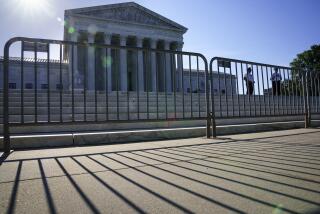Burger Court Took a Different Road : It Let Other Goals Supplant Fairness in Individual Rights Cases
- Share via
When Warren E. Burger was appointed chief justice of the United States in 1969, President Richard M. Nixon expected him to lead the Supreme Court in a more conservative direction that would undo the “damage” done by liberal Warren court decisions.
Now the chief justice’s resignation has prompted commentators from all shades of the political spectrum to evaluate whether the Burger court fulfilled its mission. Their answers to this question are fairly uniform: No conservative criminal-law “counterrevolution” occurred during Burger’s 17-year tenure.
To support this consensus, commentators point out that the Burger court not only failed to overrule Warren court landmark decisions such as Miranda vs. Arizona and Mapp vs. Ohio, but actually expanded the rights of criminal suspects in some cases. Moreover, they remind us that the “liberal” Warren court was willing on occasion to enhance the government’s crime-control powers. While conceding that the Burger court cut back on some Warren court precedents, this consensus views the Burger court’s greater emphasis on crime-control values as merely a little fine-tuning.
Most of this discussion is shallow, avoids basic questions about the specific functions of constitutional criminal procedure and fails to illuminate fundamental differences between the approaches of the two courts.
That both the Warren and the Burger courts attempted to accommodate the tensions between the protection of individual rights and the state’s need to detect and punish the guilty is a trivial similarity: No Supreme Court would risk undermining its own legitimacy, or that of the criminal-justice system, by promoting order without law. The Warren and Burger courts’ attempts to balance these competing concerns reflect the fact that criminal procedure serves functions apart from promoting reliable guilt determinations.
A useful comparison of the two courts must evaluate how each attempted to implement the independent and often conflicting functions of criminal procedure. Such an inquiry reveals that the Burger court’s conception of individual rights differed markedly from the Warren court’s view. It demonstrates that the Burger court was far less willing than its predecessor to vindicate constitutional rights at the expense of impairing the state’s capacity to reliably determine guilt. And, finally, it suggests that the two courts attempted to legitimize the system in the community’s eyes in very different ways.
Consider the treatment of the Fourth Amendment’s prescription against unreasonable government searches and seizures and the Fifth Amendment’s privilege against self-incrimination. These constitutional rights impose substantive and procedural restraints on the state’s crime-control powers to ensure that the individual is treated with dignity and respect. Judicial interpretations of the scope of such rights are influenced in part by the political context in which challenges to governmental authority arrive.
Racial, social and political unrest during the 1960s undermined the state’s moral authority to punish criminal defendants who were perceived by many to be victims of racial and class injustice. The Warren court responded to this “legitimation crisis” by broadly interpreting the substantive scope of these rights. In doing so the court sought not only to protect the individual’s liberty, property and privacy interests from undue state interference but also to increase the opportunity for effective judicial regulation of law-enforcement conduct.
The Burger court responded to a different crisis. It is no longer fashionable to speak of indigent criminal defendants as victims of racial and economic inequality. The public today sees itself as the victim of a system that does not appear to provide a tolerable degree of protection from street crime. Excluding reliable evidence of guilt in cases where the police acted in “good faith” now may have a “delegitimizing” effect because it confirms the public’s impression of a system that is all too willing to protect the victimizer instead of the victim.
The Burger court reacted to these political forces by contracting the substantive scope of Fourth and Fifth Amendment rights and by decreasing the opportunities for effective judicial review of allegations that these rights were violated. For example, the court enhanced police investigatory powers by narrowing the range of actions that qualify as a search or seizure regulated by the Fourth Amendment. The court also expanded the range of police searches and seizures that can be justified without probable cause, and diluted the probable-cause standard in cases where it still applied. Although the court did not overrule Miranda and Mapp, it severely limited the scope and effectiveness of those rulings by undermining their constitutional rationales and by carving out numerous exceptions to their exclusionary remedies.
In short, the Burger court’s approach to constitutional criminal procedure differed substantially from that of its predecessor.
The Warren court’s generous interpretation of the Fourth and Fifth amendments reflected its view that the fairness of the process was as important as the reliability of the outcome.
The Burger court’s treatment of these regulatory norms demonstrated several distinctive themes of its crime-control ideology: judicial deregulation of criminal-justice officials, a hostility to constitutional rights that impair the state’s capacity to detect the truth and a pronounced tendency to view all individual rights from a utilitarian perspective that defines their content in light of their functional effect on the system’s capacity to promote social control.
Conservatives hope and liberals fear that the Rehnquist court will mark a new conservative era. But, at least in criminal law, the era is more than a decade old.
More to Read
Get the L.A. Times Politics newsletter
Deeply reported insights into legislation, politics and policy from Sacramento, Washington and beyond. In your inbox twice per week.
You may occasionally receive promotional content from the Los Angeles Times.










